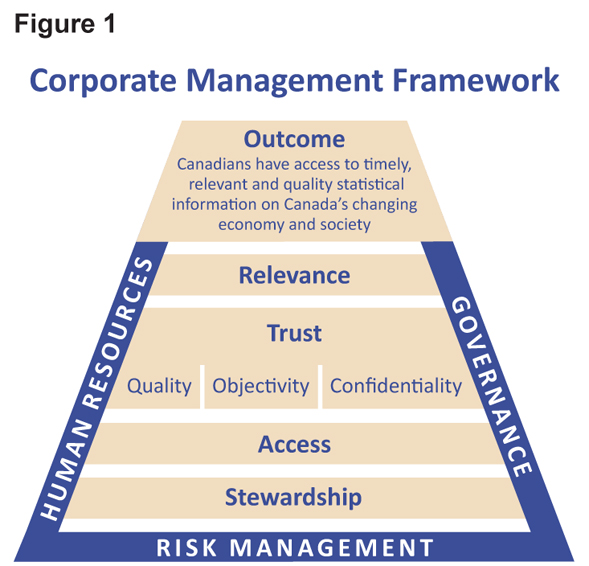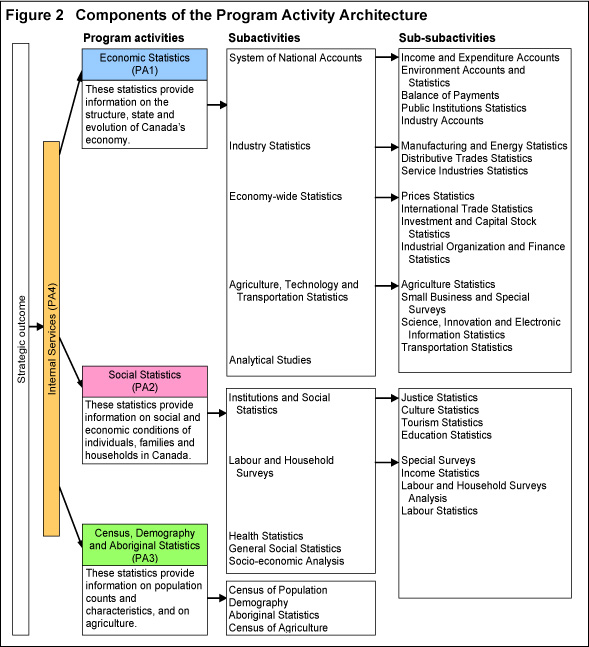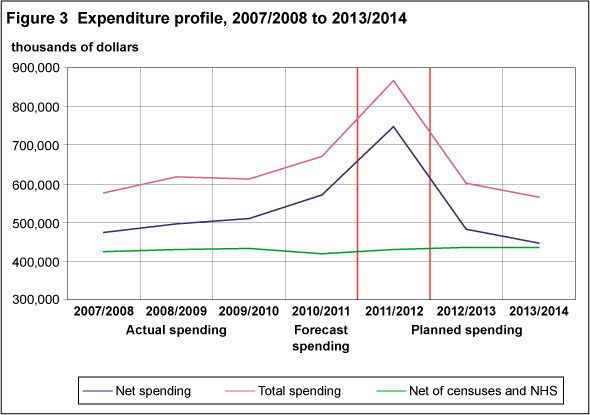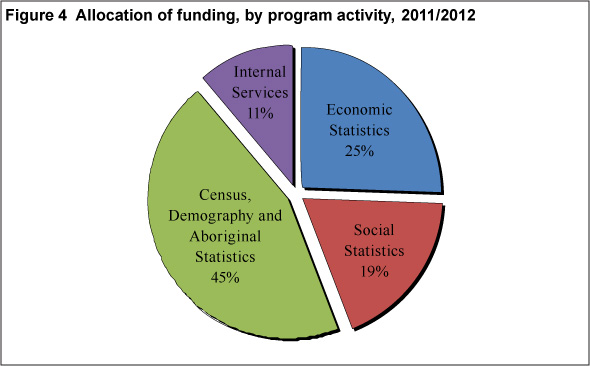Common menu bar links
Breadcrumb Trail
ARCHIVED - Statistics Canada - Report
 This page has been archived.
This page has been archived.
Archived Content
Information identified as archived on the Web is for reference, research or recordkeeping purposes. It has not been altered or updated after the date of archiving. Web pages that are archived on the Web are not subject to the Government of Canada Web Standards. As per the Communications Policy of the Government of Canada, you can request alternate formats on the "Contact Us" page.
Minister's message
As Canada's economy shows continued signs of growth following the global recession, the Harper Government has a clear vision for Canada. We remain focused on creating jobs and economic growth in all regions of Canada. We remain committed to fighting protectionism, the number one impediment to global economic recovery. And we will continue to support science and technology as it drives innovation to improve quality of life for Canadians.
In the coming year, Industry Canada and its portfolio partners will seize the opportunities of the evolving global economy. We will set the conditions for industrial success by improving the policy we put in place, making strategic investments and supporting business-focused programs and services. We are working to remove impediments to competition and to create the best climate for international investment. Industry Canada will lead efforts in developing major policy initiatives to support Canada’s digital economy and shape a whole-of-government strategy for federal tourism activities. The Department will also improve the cost-effectiveness and efficiency of its own operations and work with recovering industries and sectors to help assure a solid and prosperous future.
In 2011/2012, Statistics Canada will continue to provide Canadians with trusted information that responds to the nation’s highest priority needs to support both public and private decision making. Priorities include completing collection of the 2011 censuses of population and agriculture, completing collection of the new National Household Survey, ensuring the continued relevance and quality of our economic and social statistics and increasing the efficiency of the agency’s operations.
And, as always, I will work with the Industry portfolio partners, the private sector and other governments to create the fundamentals for a strong and competitive economy.
It is my pleasure to present this year’s Report on Plans and Priorities for Statistics Canada.
The original version was signed by Christian Paradis
Minister of Industry and Minister of State (Agriculture)
Chief Statistician's message
I am pleased to present Statistics Canada’s Report on Plans and Priorities.
As Chief Statistician of Canada, my goal is to ensure that Canadians continue to have access to a trusted source of statistics meeting their highest priority information needs. The efficient production of relevant, accessible, high-quality statistics helps to ensure that our economy functions efficiently and our society is governed effectively.
Public confidence in national statistics is fundamental to Statistics Canada. Indeed, Canada owes the success of its statistical system to a long-standing partnership between the national statistical agency and the nation’s citizens, businesses, governments and other institutions. Accurate and relevant statistical information can only be collected and produced with this continued co-operation.
This is especially true with respect to the Census of Population. In 2011, every household in Canada will receive a Census questionnaire. Statistics Canada will also conduct the Census of Agriculture and, for the first time, the voluntary National Household Survey in lieu of the previous mandatory long-form Census. Other agency priorities for 2011 are to
- deliver ongoing economic and social statistics programs
- continue to renew statistical programs
- improve the agency's business processes and further integrate its results-based corporate infrastructure.
Statistics Canada is committed to ensuring the relevance, accessibility and quality of the nation's statistics. I invite readers to learn more about the work of their national statistical agency by visiting our website, www.statcan.gc.ca. Your feedback is always welcome.
The original version was signed by Wayne R. Smith
Chief Statistician of Canada
Section 1 — Agency overview
1.1 Raison d’être and responsibilities
Statistics Canada seeks to ensure that Canadians have access to a trusted source of statistics on Canada that meet their highest priority information needs. Access to trusted statistical information is an essential underpinning of democratic societies, both to support evidence-based decision-making in the public and private sectors and to inform debate on public policy issues.
Under the Constitution Act of 1867, “census and statistics” was made a federal jurisdiction. Parliament has exercised its responsibility for the census and statistics primarily through the Statistics Act. The Act creates Statistics Canada as Canada’s national statistical office and establishes its mandate, powers and obligations. Under the Act, Statistics Canada must collect, compile, analyse and publish statistical information on the economic, social and general conditions of the country and its people. The Act specifically requires that Statistics Canada conduct censuses of population and agriculture in 1971 and every fifth year thereafter.
Statistics Canada is empowered to conduct surveys of businesses and households on both a voluntary and a mandatory basis; censuses are always mandatory under the Act. Administrative records can also be acquired to assist in the agency’s work. In tandem with these powers, the agency is charged with ensuring the confidentiality of information in its hands and limiting the use of that information to statistical purposes.
Finally, to promote the efficiency of the national statistical system, Statistics Canada is mandated to collaborate with other government departments, as well as provincial and territorial governments, to develop a well-integrated, coherent national system of statistics that minimizes duplication and reporting burden on households and businesses.
Statistics Canada is also mandated under the Corporations Returns Act to collect and publish information on inter-corporate ownership in Canada, with an emphasis on foreign ownership of Canadian enterprises. The particularity of the Corporation Returns Act is that it allows Statistics Canada to disclose information on the ownership of individual corporations, something that would be prohibited under the Statistics Act.
Numerous federal and provincial laws and regulations specifically require information from Statistics Canada for their operation. Some key examples are: the Canada Pension Plan Act (Consumer Price Index); the Employment Insurance Act (Labour Force Survey); the Federal–Provincial Fiscal Arrangements Act (numerous economic and demographic measures); the Income Tax Act (Consumer Price Index); the regulations to the Official Languages Act (census data on official languages); and the Electoral Boundaries Readjustment Act (census).1.2 Statistics Canada's Corporate Management Framework and strategic outcome

Statistics Canada’s Corporate Management Framework illustrates how the agency delivers its strategic outcome. The following paragraphs briefly describe this framework and the enablers that allow the strategic outcome to be achieved.
Relevance is defined as producing information that meets Canada’s evolving and highest priority needs. Relevance depends on user needs: to understand these needs, both present and future, and to ensure that its products and services meet them, Statistics Canada monitors data usage, and consults with users, stakeholders and advisory committees. Meeting those needs means taking into account how quickly the information is required. A statistical agency’s programs must evolve continuously to stay relevant.
Trust has three dimensions: quality, objectivity and confidentiality. Users must be able to trust that the agency’s statistics are factual and reliable representations of the social and economic worlds they are meant to describe; that they are objective; and that respondents’ information is kept confidential. Quality can also be conceived of in terms of accuracy, interpretability and consistency. These dimensions are described in Statistics Canada’s Quality Assurance Framework http://www.statcan.gc.ca/pub/12-586-x/12-586-x2002001-eng.pdf. To maintain and improve data quality, several measures work jointly at various levels throughout Statistics Canada, including a strong program of research and innovation in statistical methods, regular updates of standard classifications and regular internal quality reviews to identify and eliminate weaknesses—which are also an opportunity to share and promote best practices.
Access refers to awareness and use of Statistics Canada’s rich inventory of information holdings. Access has two channels: publicly available data and microdata for statistical and research use. Access to microdata files is managed to ensure the confidentiality of individual households and businesses is maintained. The agency’s principal access conduit for publicly available statistics is its website. The key conduit for detailed microdata is the national network of Research Data Centres, designed for statistical research in a secure, controlled setting. Both these mechanisms aim to meet the needs of Statistics Canada’s diverse user community.
Stewardship, in the form of strategic leadership and proactive management of resources and assets, is a Statistics Canada tradition. Ensuring probity and value for money in all aspects of our organization is a key component of our Corporate Management Framework. Statistics Canada strives to be a highly efficient organization: information is produced at the lowest possible cost. It has in place a unique governance and management structure, as well as a dynamic system to innovate, manage risks, and anticipate and address emerging issues and opportunities.
The enablers that allow the strategic outcome to be achieved are described below.
Human resources are by far Statistics Canada’s most important asset. Therefore, effective human resource management is a key factor in achieving the agency’s strategic outcome. Given the specialized skill requirements of a statistical agency, effort is focused on recruitment, training, career advancement and maintaining a positive workplace. Statistics Canada fully embraces the Public Service Renewal initiatives in its human resource management practices.
Governance—Statistics Canada has a mature and effective governance and management structure, which integrates strategic priority setting and decision making and ensures accountability.
An established system of corporate-level committees consults managers and recommends strategic options for program development and delivery. Committee membership includes senior managers from across Statistics Canada. The Policy Committee is the lead committee, responsible for strategic direction and corporate-level management and decisions. All significant corporate issues are reviewed at this highest level. The Chief Statistician, as chair of the Policy Committee, renders final decisions.
The decision-making infrastructure, which includes an independent Departmental Audit Committee, encourages innovation and strategies to improve efficiency.
This structure also ensures good governance of material resources—in particular the information and communication equipment and technology that is essential for a modern statistical agency.
Risk management—In keeping with government-wide expectations of good governance and modern comptrollership, Statistics Canada places great emphasis on managing risk in all planning and program delivery activities. Statistics Canada’s risk management model is described in Section 1.6.
Statistics Canada’s strategic outcome, which is supported by a framework of program activities and subactivities, is as follows:Strategic outcome
Canadians have access to timely, relevant and quality statistical information on Canada's changing economy and society for informed debate, research and decision making on social and economic issues.
All Statistics Canada’s activities contribute to the achievement of its strategic outcome and of its two expected results:
- Statistics produced by Statistics Canada are available through a wide range of easily accessible media formats and venues.
- Canadians are aware of the availability of these statistics and of their high quality, and of the professionalism and non-partisanship of Statistics Canada.
1.3 Strategic outcome and Program Activity Architecture
Statistics Canada allocates its resources in accordance with its Program Activity Architecture. Established in consultation with the Treasury Board Secretariat, this architecture reflects Government of Canada standards for transparent and accountable reporting. The architecture comprises three main program activities, and subactivities within each, based on subject matter: Economic Statistics; Social Statistics; and Census, Demography and Aboriginal Statistics. A fourth program activity covers Internal Services.
The subactivities correspond to program activities sponsored by branches in Statistics Canada’s organizational structure. Within the subactivities is a third level of sub-subactivities, which correspond to the agency’s divisions. In all cases, the accountability for a program resides with a division in the organizational structure, but the delivery of the program activities involves the contribution of work units from across the organization, defined as a matrix management structure.

1.4 Planning summary
Financial and human resources
Statistics Canada’s statistical program is funded from two sources: direct parliamentary appropriations and cost-recovery activities. In recent years, the agency’s ‘respendable’ cost-recovery revenues—revenues it is authorized to spend on the activity that generated them—have generally added more than $100 million annually to its total resources. A large portion of these respendable revenues is from federal departments to fund specific statistical projects. Statistics Canada assumes that cost-recovery revenues will remain at the same level each year for the foreseeable future.
The total planned spending and total planned human resources for the next three fiscal years are summarized in the following tables. The tables show the year-to-year variation in Statistics Canada’s resources, the result of the cyclical activity supporting the Census of Population, the National Household Survey (NHS), and the Census of Agriculture. Funding typically peaks in the fiscal year in which the censuses are conducted.
| 2011/2012 | 2012/2013 | 2013/2014 |
|---|---|---|
| 747,595 | 482,764 | 446,049 |
| 2011/2012 | 2012/2013 | 2013/2014 |
|---|---|---|
| 6,461 | 5,812 | 5,390 |
Notes
Planned spending amounts are presented net of respendable revenue.
Planned spending and full-time equivalent (FTE) changes between years are mostly due to the cyclicality of the 2011 census programs, which peak in 2011/2012 and wind down in subsequent years.
Totals may differ between tables because of rounding.
Planned spending
Total planned spending for each program activity, for each of the next three fiscal years, is detailed below. Detailed information, by program activity, on planned activities, indicators, targets, and timelines is presented in Section 2.
| Program Activity | Forecast spending | Planned spending | Alignment to Government of Canada outcomes | ||
|---|---|---|---|---|---|
| 2010/2011 | 2011/2012 | 2012/2013 | 2013/2014 | ||
| thousands of dollars | |||||
| Economic Statistics | 203,457 | 214,120 | 214,940 | 214,451 | A transparent, accountable and responsive federal government. |
| Social Statistics | 191,429 | 191,293 | 197,424 | 197,169 | |
| Census, Demography and Aboriginal Statistics | 188,826 | 369,186 | 92,864 | 56,007 | |
| Internal Services | 86,919 | 86,962 | 87,733 | 87,710 | … |
| Budgetary Main Estimates (gross) | 670,631 | 861,561 | 592,961 | 555,337 | … |
| Less: Respendable revenue | 97,515 | 120,000 | 120,000 | 120,000 | … |
| Subtotal | 573,116 | 741,561 | 472,961 | 435,337 | … |
| Adjustments to Economic Statistics1 | 0 | 6,034 | 9,803 | 10,712 | … |
| Total planned spending | 573,116 | 747,595 | 482,764 | 446,049 | … |
|
Notes |
|||||
1.5 Contribution of priorities to the strategic outcome
Table 4 summarizes Statistics Canada’s operational and management priorities with a list of planned activities and links to the Program Activity Architecture as well as the strategic outcome. Detailed information, by program activity, on planned activities, indicators, targets and timelines is presented in Section 2.
| Priority | Type | Link to Program Activity | Contribution to the strategic outcome and planned activities | Why is this a priority? |
|---|---|---|---|---|
| Operational priorities | ||||
| Deliver ongoing economic and social statistics programs | Ongoing | Economic Statistics Social Statistics |
Relevance |
Statistics Canada’s strategic outcome is to ensure that Canadians have access to a trusted source of statistics meeting their highest priority information needs. The Statistics Act directs the agency to collect, compile, analyse, abstract and publish statistical information relating to the commercial, industrial, financial, social, economic and general activities and
condition of the people. Those duties include producing gross domestic product and other topical economic data, as well as current high-quality data on key areas of social policy concern including employment, education, health and justice. Planned activities
|
| Conduct the Census of Population, the Census of Agriculture, and the National Household Survey | Ongoing | Census, Demography and Aboriginal Statistics | Relevance Trust Access |
Statistics Canada is mandated by legislation to perform a census every five years: 2011 is the year of data collection for the Censuses of Population and Agriculture. These data, along with the data being collected in the new National Household Survey, will produce a statistical portrait of both the Canadian population and of Canada’s farms and their operators. The data are
widely used by all levels of government for policy planning and program development and delivery. Planned activities
|
| Continue to renew statistical programs | Ongoing | Economic Statistics Social Statistics Census, Demography and Aboriginal Statistics |
Relevance Trust Efficiency |
Statistics Canada is responsible for producing relevant and high-quality statistics. Canada and the world continue to evolve. To ensure trust in our statistical programs, the agency must also evolve to stay relevant and maintain their quality. It is a priority to update our programs to reflect the changing reality of Canada’s economy and society while ensuring their quality and
continuity. Planned activities
|
| Management priorities | ||||
| Improve the agency’s business processes and further integrate its results-based corporate infrastructure | Ongoing | Internal Services | Relevance Trust Access Efficiency |
Improve the effectiveness and efficiency of corporate business processes, and further integrate human resource planning, informatics technology, and program and project planning: these are required to ensure the agency remains relevant and accountable over the long term. Planned activities
|
1.6 Risk analysis
While risk management has always been an important part of Statistics Canada’s operations, significant progress has been made over the past year by bringing risk considerations to the forefront using a risk management model.
Statistics Canada is implementing an integrated model to manage risk. In this model, risks are identified, assessed, dealt with, and monitored. In 2010/2011, corporate and operational risks were identified by senior managers, program managers, and subject-matter experts, then categorized by corporate objective (relevance, trust, access, and stewardship). For each risk identified, expert opinion was obtained from program managers on the probability and potential impact of the residual component of that risk, after taking mitigating strategies into consideration. Where that residual risk was deemed significant, information was collected on the estimated cost of implementing further mitigation strategies and on whether these investments would be worth the cost.
The risk management model includes an agency-wide picture of all identified risks through a detailed risk register and a corporate risk profile considering not only operational or short-term risks, but longer-term strategic risks to the organization. This information is being used to provide context to project proposals as part of the annual long-term planning process.
The 2010/2011 Corporate Risk Profile has identified the following major corporate risks:
- Public trust, confidence and co-operation: The voluntary status of the majority of surveys make the integrity of the statistical program dependent on the co-operation and participation of the public, businesses and institutions in data collection activities. The public’s trust and confidence in the quality and objectivity of Statistics Canada outputs are fundamental pillars of the organization. Domestic and international use of agency outputs may be affected if trust in the organization is compromised and the agency’s professional credibility is questioned.
- Budget and resources: Federal budgets and strategic program reviews may result in adjustments to the resources available to the agency, including respendable revenues from other government departments and agencies.
- Legislation and statutory data requirements: Two-thirds of the agency’s programs have statutory and regulatory data requirements. Unilateral or unanticipated changes in these data requirements may have an impact on statistical programs used to fulfill them.
- Leadership and intergovernmental co-ordination of the national statistics program: Changes in federal-provincial partnerships, or mutually beneficial relationships with other governments may affect the scope, quality or timeliness of data available to the national statistics program.
1.7 Expenditure profile

Total and net spending will peak in 2011/2012, when the 2011 Census of Population and NHS and the 2011 Census of Agriculture will be conducted. Expenditures will drop sharply in 2012/2013 as these activities begin to wind down. This pattern is typical for the agency because of the cyclical nature of the census programs—witness the relative stability of the agency’s spending when the census and cost-recovery activities are removed.
Figure 4 shows how net funding will be distributed by program activity in 2011/2012. In this peak year for census activity, Census, Demography and Aboriginal Statistics will account for 45% of overall spending, a larger share than in 2010/2011. Economic Statistics will account for 25% of spending in 2011/2012 and Social Statistics, 19%.

1.8 Estimates by vote
For information on Statistics Canada’s organizational votes and/or statutory expenditures, please see the 2011/2012 Main Estimates publication. An electronic version is available at http://www.tbs-sct.gc.ca/est-pre/20112012/me-bpd/toc-tdm-eng.asp.
